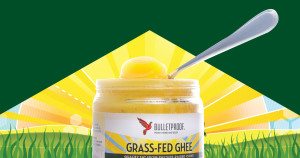
Bulletproof Grass-fed Ghee is here!
Ghee is a clarified form of butter that’s been popular in Indian and Southeast Asian cooking for thousands of years. It has a host of benefits, including greater nutrient density than butter and more versatility when you’re cooking.
Is grass-fed ghee better than grass-fed butter?
Sometimes. Depending on the situation, you may want ghee instead of butter, or vice versa. Both are pretty damn good, and you’ll want to stock both in a fully Bulletproof kitchen.
Here’s a quick primer on ghee – what it is, what it does for you, and how you can use it.
[embedded content]
Ghee is more nutrient-dense than butter
Really good ghee has a deep yellow-orange color that reflects its high vitamin A content. It’s also got a respectable dose of vitamins D, E, and K, and has twice the short- and medium-chain fatty acids that butter has. On top of that, ghee has more butyrate, an anti-inflammatory fat that keeps you gut lining and metabolism in good shape [1].
Bulletproof Ghee is particularly nutrient-dense because it comes from grass-fed cows.
Ghee has virtually no dairy in it
Butter is almost pure fat, but it still has trace amounts of casein and lactose, the two parts of dairy that most often cause allergies. Casein is what gives butter its wonderful creaminess.
Ghee has either no casein or lactose or a vanishingly small amount, meaning even very dairy-sensitive people can usually eat it. It blends into Bulletproof Coffee well and is a decent substitute for butter in most recipes, although it’s more oily than butter and may change the consistency of a dish slightly. If you do make BP Coffee with ghee, know that it won’t foam the way butter does, so you won’t get that frothy latte top. Don’t worry – it’s still tasty.
Ghee is great for cooking
Smoke point determines how hot you can cook a fat before it oxidizes. Butter smokes at 350°F because the casein and lactose start to burn. Ghee, on the other hand, is one of the most stable cooking fats around. You can heat it up to a full 485°F, making it ideal for pan-frying or baking pretty much anything – far better than butter, coconut oil, MCT oil, or olive oil.
Ghee has a nutty flavor and tastes more buttery than butter itself. It holds up to strong spices well, which is one reason it’s a staple of Indian and Thai cooking. Ghee also pulls fat-soluble flavors and nutrients out of spices when you cook the two together. It’s ideal for curries, sauces, and other slow-cooked or simmered dishes. It’s also great drizzled over veggies with a bit of salt.
Oh, and you don’t have to refrigerate it. It’s shelf-stable and won’t go bad for years.
How do you make ghee?
It’s actually pretty easy. When you simmer butter for a while, the water and dairy proteins rise to the top, and the pure, clear butter fat stays at the bottom. Skim the water and protein off and you’re left with ghee – a concentrated, clarified form of butter.
You can try making your own ghee at home. Start with a high-quality grass-fed butter like Kerrygold. Just simmer it over medium heat for 15-20 minutes, then let it cool down for 2-3 minutes. Pour off any water and put the remaining protein and fat through a strainer that’s double-lined with cheesecloth. The fat will go through; the dairy protein will not.
Give Bulletproof Grass-fed Ghee a try and see what you think. It’s great in this delicious Bulletproof green curry recipe:
Bulletproof Thai green curry
Makes enough for 2-4 people
Curry paste:
3-8 fresh thai chilies, stems removed (3 will add mild heat; 8 will kick your ass)
1 stalk lemongrass (just the white part)
4 cloves garlic
1 inch fresh ginger, peeled
Juice of 1 lime
Handful of basil leaves
1 tbsp olive oil
1 tbsp Brain Octane Oil or coconut oil
Base:
2 tbsp. Bulletproof Grass-fed Ghee
1 onion, diced (optional; eliminate if you’re sensitive)
1 can full-fat coconut milk (guar gum-free, if you can find it)
½ cup free-range chicken stock or vegetable stock
Himalayan pink salt or sea salt, to taste
Meat:
½ lb. grass-fed steak OR pastured chicken breast, cubed
Veggies (optional):
Broccoli
Cauliflower
Carrots
Directions:
- Put all the curry paste ingredients except lime juice in a food processor or blender and blend until smooth.
- Melt 1 tbsp. ghee in a saucepan. Add meat and lightly cook. Remove the meat and set aside.
- Add curry paste and remaining ghee to the saucepan. Cook over medium heat for 2-3 minutes.
- Add onions (optional) and cook them down for 5-10 minutes.
- Add half the coconut milk. Simmer uncovered for 10 minutes. The curry should begin to thicken.
- Add the remaining coconut milk, chicken stock, vegetables, and meat. Simmer for another 3-4 minutes. Salt to taste. Add lime juice right at the end of cooking.
Serve the curry over white rice for a carb day, or straight up to stay low-carb. Try adding two or three freshly cracked cardamom pods to the rice before you cook it. It’ll give the rice a subtle flavor – and the cardamom pods will rise to the top at the end of cooking, so you can scoop them right out.
You can get Bulletproof Ghee here. Thanks for reading and have a great week!
References
Source: Bulletproof


